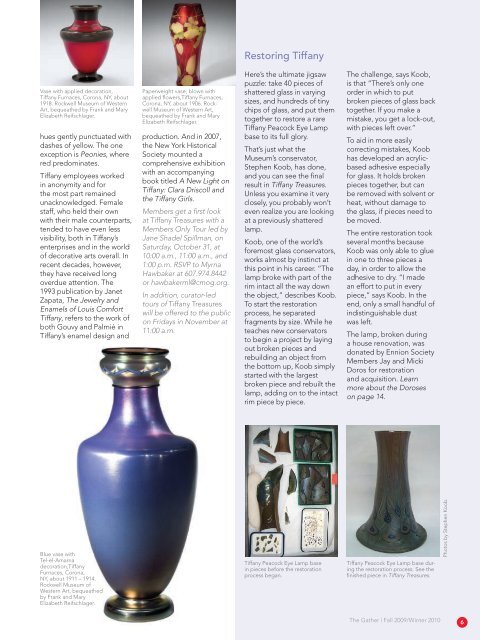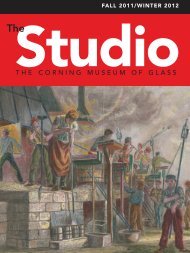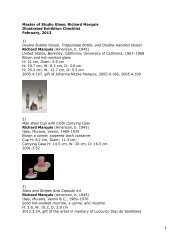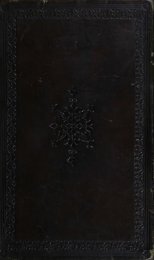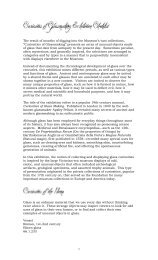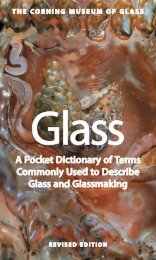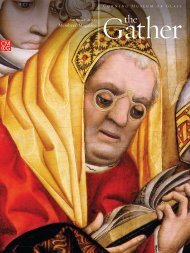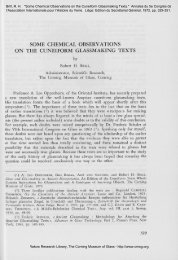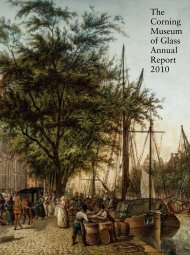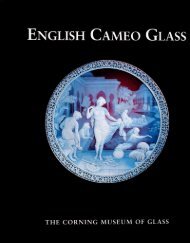The Gather - Corning Museum of Glass Members' Magazine (Fall ...
The Gather - Corning Museum of Glass Members' Magazine (Fall ...
The Gather - Corning Museum of Glass Members' Magazine (Fall ...
You also want an ePaper? Increase the reach of your titles
YUMPU automatically turns print PDFs into web optimized ePapers that Google loves.
Vase with applied decoration,<br />
Tiffany Furnaces, Corona, NY, about<br />
1918. Rockwell <strong>Museum</strong> <strong>of</strong> Western<br />
Art, bequeathed by Frank and Mary<br />
Elizabeth Reifschlager.<br />
hues gently punctuated with<br />
dashes <strong>of</strong> yellow. <strong>The</strong> one<br />
exception is Peonies, where<br />
red predominates.<br />
Tiffany employees worked<br />
in anonymity and for<br />
the most part remained<br />
unacknowledged. Female<br />
staff, who held their own<br />
with their male counterparts,<br />
tended to have even less<br />
visibility, both in Tiffany’s<br />
enterprises and in the world<br />
<strong>of</strong> decorative arts overall. In<br />
recent decades, however,<br />
they have received long<br />
overdue attention. <strong>The</strong><br />
1993 publication by Janet<br />
Zapata, <strong>The</strong> Jewelry and<br />
Enamels <strong>of</strong> Louis Comfort<br />
Tiffany, refers to the work <strong>of</strong><br />
both Gouvy and Palmié in<br />
Tiffany’s enamel design and<br />
Blue vase with<br />
Tel-el-Amarna<br />
decoration,Tiffany<br />
Furnaces, Corona,<br />
NY, about 1911 – 1914.<br />
Rockwell <strong>Museum</strong> <strong>of</strong><br />
Western Art, bequeathed<br />
by Frank and Mary<br />
Elizabeth Reifschlager.<br />
Paperweight vase, blown with<br />
applied fl owers,Tiffany Furnaces,<br />
Corona, NY, about 1906. Rockwell<br />
<strong>Museum</strong> <strong>of</strong> Western Art,<br />
bequeathed by Frank and Mary<br />
Elizabeth Reifschlager.<br />
production. And in 2007,<br />
the New York Historical<br />
Society mounted a<br />
comprehensive exhibition<br />
with an accompanying<br />
book titled A New Light on<br />
Tiffany: Clara Driscoll and<br />
the Tiffany Girls.<br />
Members get a fi rst look<br />
at Tiffany Treasures with a<br />
Members Only Tour led by<br />
Jane Shadel Spillman, on<br />
Saturday, October 31, at<br />
10:00 a.m., 11:00 a.m., and<br />
1:00 p.m. RSVP to Myrna<br />
Hawbaker at 607.974.8442<br />
or hawbakerml@cmog.org.<br />
In addition, curator-led<br />
tours <strong>of</strong> Tiffany Treasures<br />
will be <strong>of</strong>fered to the public<br />
on Fridays in November at<br />
11:00 a.m.<br />
Restoring Tiffany<br />
Here’s the ultimate jigsaw<br />
puzzle: take 40 pieces <strong>of</strong><br />
shattered glass in varying<br />
sizes, and hundreds <strong>of</strong> tiny<br />
chips <strong>of</strong> glass, and put them<br />
together to restore a rare<br />
Tiffany Peacock Eye Lamp<br />
base to its full glory.<br />
That’s just what the<br />
<strong>Museum</strong>’s conservator,<br />
Stephen Koob, has done,<br />
and you can see the fi nal<br />
result in Tiffany Treasures.<br />
Unless you examine it very<br />
closely, you probably won’t<br />
even realize you are looking<br />
at a previously shattered<br />
lamp.<br />
Koob, one <strong>of</strong> the world’s<br />
foremost glass conservators,<br />
works almost by instinct at<br />
this point in his career. “<strong>The</strong><br />
lamp broke with part <strong>of</strong> the<br />
rim intact all the way down<br />
the object,” describes Koob.<br />
To start the restoration<br />
process, he separated<br />
fragments by size. While he<br />
teaches new conservators<br />
to begin a project by laying<br />
out broken pieces and<br />
rebuilding an object from<br />
the bottom up, Koob simply<br />
started with the largest<br />
broken piece and rebuilt the<br />
lamp, adding on to the intact<br />
rim piece by piece.<br />
Tiffany Peacock Eye Lamp base<br />
in pieces before the restoration<br />
process began.<br />
<strong>The</strong> challenge, says Koob,<br />
is that “<strong>The</strong>re’s only one<br />
order in which to put<br />
broken pieces <strong>of</strong> glass back<br />
together. If you make a<br />
mistake, you get a lock-out,<br />
with pieces left over.”<br />
To aid in more easily<br />
correcting mistakes, Koob<br />
has developed an acrylicbased<br />
adhesive especially<br />
for glass. It holds broken<br />
pieces together, but can<br />
be removed with solvent or<br />
heat, without damage to<br />
the glass, if pieces need to<br />
be moved.<br />
<strong>The</strong> entire restoration took<br />
several months because<br />
Koob was only able to glue<br />
in one to three pieces a<br />
day, in order to allow the<br />
adhesive to dry. “I made<br />
an effort to put in every<br />
piece,” says Koob. In the<br />
end, only a small handful <strong>of</strong><br />
indistinguishable dust<br />
was left.<br />
<strong>The</strong> lamp, broken during<br />
a house renovation, was<br />
donated by Ennion Society<br />
Members Jay and Micki<br />
Doros for restoration<br />
and acquisition. Learn<br />
more about the Doroses<br />
on page 14.<br />
Tiffany Peacock Eye Lamp base during<br />
the restoration process. See the<br />
fi nished piece in Tiffany Treasures.<br />
<strong>The</strong> <strong>Gather</strong> | <strong>Fall</strong> 2009/Winter 2010<br />
Photos by Stephen Koob.<br />
6


